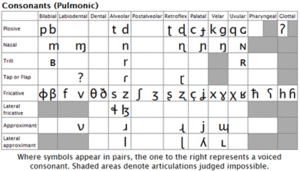Difference between revisions of "Consonant (definition)"
Kmccullough (talk | contribs) (visual added- IPA.org credit) |
Kmccullough (talk | contribs) m |
||
| Line 11: | Line 11: | ||
| − | For a complete description of Gaelic consonants and its phoneme inventory, see the main article at [[Sounds of Scottish Gaelic]]. | + | ''For a complete description of Gaelic consonants and its phoneme inventory, see the main article at [[Sounds of Scottish Gaelic]].'' |
==See Also== | ==See Also== | ||
Revision as of 16:09, 16 September 2020
Phonetically, consonants (C) are sounds that involves a significant occlusion (closure or constriction) of the vocal tract. These sounds are traditionally characterized by voicing, place of articulation, and manner of articulation features; these are listed below and illustrated in the graphic to the right.
- Voicing (+voice, -voice)
- Place (labial, labiodental, dental, alveolar, postalveolar, palatal, retroflex, velar, uvular, pharyngeal, glottal)
- Manner (plosive, nasal, trill, tap, fricative, aproximant)
Such features are used to distinguish between consonantal segments and define natural classes (e.g. continuant, coronal, etc.).
Consonants help define the phonotactics of a language acting as onsets, codas, and occasionally nuclei of syllables. Consonants contrast with vowels which are articulated with an unobstructed vocal tract.
For a complete description of Gaelic consonants and its phoneme inventory, see the main article at Sounds of Scottish Gaelic.
See Also
External Links
- Interactive IPA Charts
- http://akerbeltz.org/index.php?title=Consonants
- http://en.wikipedia.org/wiki/Consonant
References
- Crystal, D. (2008) Dictionary of Linguistics and Phonetics. 6th Edition. Wiley-Blackwell.
- Ladefoged, D. (2010) A Course in Phonetics. 6th Edition. Wadsworth Publishing.
- Matthews, P. H. (1997) The Concise Oxford Dictionary of Linguistics. Oxford: Oxford University Press.
